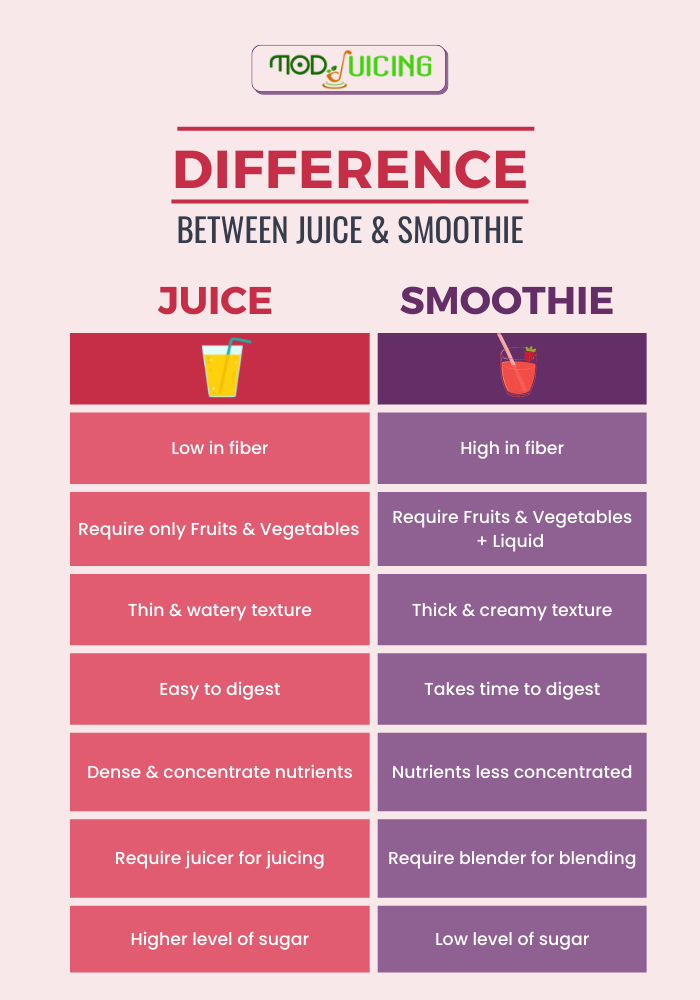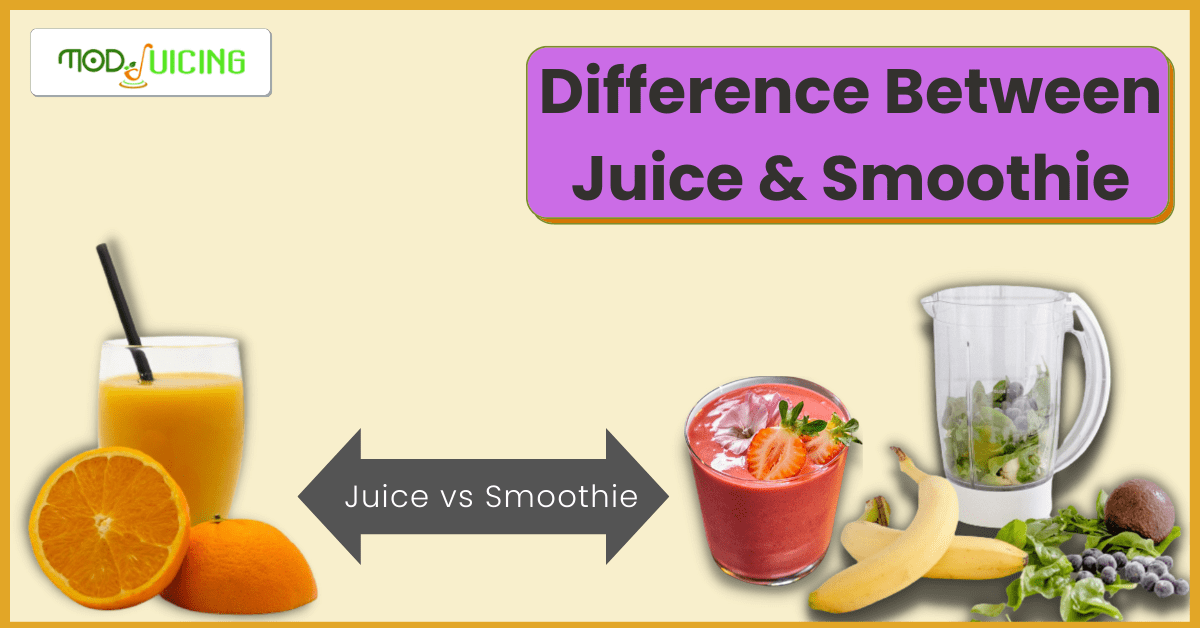Are you someone who can’t differentiate between a refreshing glass of juice and a creamy smoothie? You’re not alone! Many people struggle to understand the difference between these two popular drinks. In both drinks, fruit, and vegetables are used to create a nutrient-rich beverage.
A comprehensive study shared by Harvard Health Publishing shows that consuming five servings a day of fruits & vegetables lowers the chances of multiple diseases & boosts our overall health system. Drinking five servings daily may seem challenging, but juices and smoothies make it easy. It’s interesting, but what sets them apart?
There are several key distinctions that set juice and smoothie apart. In this blog post, we’ll be exploring the 7 main differences between juice and smoothie. From their nutritional value to their preparation method, we’ll break down everything you need to understand to make an informed decision the next time you’re at the juice bar. So, this post is for you, whether you’re a juice lover or a smoothie fanatic!
Let’s try to understand the difference and decide which one to choose.
Understanding the Difference Between a Juice & a Smoothie
There’s a significant difference between juice & a smoothie. The fundamental point of difference is ‘Fiber’, an undigestible carbohydrate having multiple roles in our body. But when we dig deeper, we come to know that some other factors make them entirely different from each other. The characteristics which distinguish both drinks are listed below:
1. Fiber Ratio
The first difference everyone knows is the ‘fiber’ content that juices lack. Usually, juices contain almost 10% (only soluble fiber) of the total fiber found in fruits & vegetables.
Smoothies hold the full content of the produce, like juice, pulp, and sometimes peel. In smoothies, you get juice and all the fiber (soluble and insoluble).
2. Ingredients
Juicing involves only fruits & veggies to squeeze out the juices. No other ingredient is required in juicing. On the other hand, smoothies are prepared in a blender by adding fruits & vegetables (a solid part) with a liquid to adjust the consistency of the drink.
In smoothies, a liquid plays a vital role in its consistency & it enhances the nutritional value of the drink. You can choose your favorite liquid from a huge list of healthy liquids to improve the texture & taste of smoothies.
3. Texture
Juices are thin & watery in texture as they contain only the liquid part of the produce. Meanwhile, smoothies come in thick & creamy textures that depend on the ingredients and the liquid you add.
4. Digestibility
Juices are watery and thin in consistency which makes them easy to digest. Your stomach works less while absorbing the nutrients from the juices. In contrast, smoothies contain juice and pulp (fiber) that make your stomach work more to digest & process them.

5. Nutrients Concentration
Juices have more concentrated nutrients of fruits & veggies. They provide instant energy as the juices have more digestibility than smoothies. On the other hand, smoothies carry juice, together with fiber, making them less nutritiously concentrated than juice. Due to their slow digestibility, smoothies take time to provide energy.
6. Preparation Method
Juices are extracted by using juicer machines. Juicer separates the juice and pulp of fruits & vegetables. Smoothies are prepared using a blender machine that grinds & mixes the solid & liquid content of the smoothie.
7. Sugar Level
Juices contain more concentrated nutrients of fruits & vegetables; hence, they have higher sugar levels which may spike up your sugar count. But in smoothies, you get less potent nutrients with fiber, making them less sugary than juices.
Do You Lose Nutrients when Juicing or Blending?
In juicing & blending process, there are machines involved that may create some heat if operated continuously for a long time. The heat may destroy some vitamins present in the drink. But in household usage, juicers & blenders are usually operated for a very short time. So there is almost no chance of losing nutrients in juicing or blending. You can have your drink without worrying about deteriorating the nutrients in your juice or smoothie.
Juice vs Smoothie Cleansing – For Weightloss
If you habitually follow juice fasting or cleansing for a few days and want your body to detox toxins, extra fats & calories, you must consume both juices & smoothies. This way, you’ll get a precise balance of nutrition and fiber as well as a proportionate sugar level.
Health experts suggest juice fasting is a great way, if done right, to throw out excess fats & toxins from your body. Hence, it may facilitate your weight loss struggle. But remember, don’t do this practice without consulting your doctor. A health practitioner or a nutritionist may suggest a better menu according to your body’s requirements.
Juicing vs Blending – which is better?
First, let’s summarize juicing and blending below:
Juicing is a process of extracting or squeezing all the liquid out of fruits & vegetables with the help of a juicer. All the nutrients come in the juice from the produce. This way, you get maximum vitamins, minerals & other phytonutrients from fruits & vegetables and a tiny amount of fiber (only soluble fiber). In juicing, you lose most of the fiber, a healthy part of the produce.
Blending is the process of mixing or blending fruits & vegetables with a liquid to form a drinkable beverage. It includes whole fruits & vegetables. In a smoothie, you get all the goodness of fruits & vegetables as well as fiber (both soluble & insoluble). So, it’s a complete package in a glass to take advantage of the beverage.
Which is better? Both are healthy & nutritious. Juicing provides hydrating liquid infused with all the nutrition of fruits & vegetables. While blending provides whole fruits & vegetables in the form of smoothies retaining both nutrition and fiber.
The choice depends on your priorities; in cases where fiber is already part of your primary diet and you are more concerned with the nutritional value, you can select juicing. But if you prefer both nutrition & fiber, you can stick with smoothies (blending). Or you may try both on alternate days.
